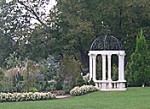
We are back to high temperatures; everyday is well over 90 (as high as 99) with high humidity and evening showers. I think the plants went on vacation and I don’t blame them. I have stuck to morning and evening to complete gardening chores and have stayed out of the heat as much as possible. The head gardener, on the other hand, seems to thrive in the heat and works all day in the sun, this week weaving the canes of climbing roses into the arbors.
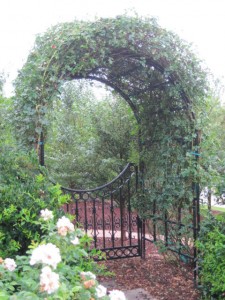
The roses were very bushy and looked like they needed a hair cut badly; I wish I had a “before” picture so everyone could see how much the trim job improved things. Believe me, this trim tidy look is all head gardener’s doing. He stood on a ladder for several hours weaving the canes into the arbor The canes of this rose (‘Awakening’) are very flexible and the thorns are hooked backward so no ties or cutting was necessary.
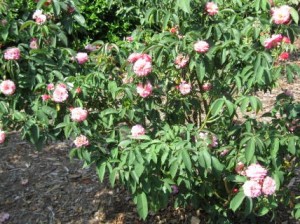
Several roses are ending their second bloom and others are beginning their third. One of the prettiest roses in the rose garden right now is the polyantha ‘Leonie Lamesch’. The bush is not the best looking, in fact, it seems to struggles through the winter and takes some time to recover in the spring.
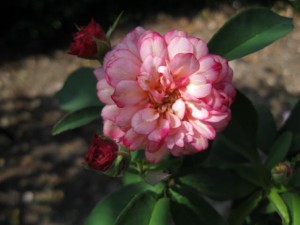
The flowers, however, are very unusual in color; each one is a mix of various shades of copper, orange, and red with the darker colors on the tips of the petals. The colors fade as the flowers mature so that by the time the flower is done it is white with touches of crimson on the edges of the petals. Quite beautiful.
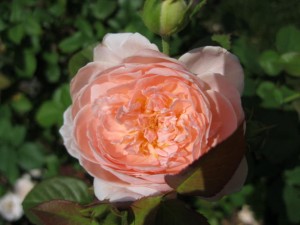
The second beautiful rose right now is David Austen’s ‘Ambridge Rose’. I am a great admirer of David Austen roses but will only grow those that are disease resistant and relatively small, leaving me few choices. But ‘Ambridge’ is a beauty with a lovely apricot-pink color and a sweet myrrh-like fragrance. It repeats quickly and is self-cleaning.
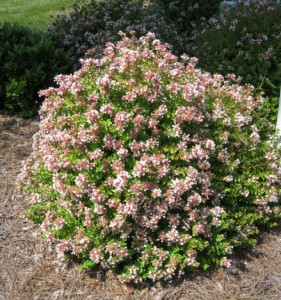
Outside the rose garden we have a hillside of shrubs and trees. The abelias are beginning to bloom there making a nice setting for the rose garden.
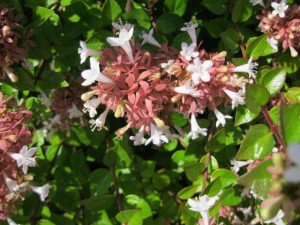
Although the flowers appear as a pale pink haze at a distance they reveal an interesting character when viewed close up.
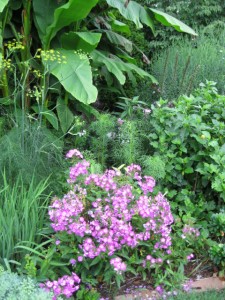
The outstanding plant in the formal garden this week is the garden phlox, Phlox paniculata ‘Laura’ with its purple color and white eye. It has had a hard time in this location for the past two years because of encroaching iris, rue, banana and fennel but I made a commitment to let it have its space this year and it has responded well.
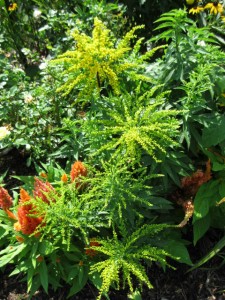
In the yellow border the earlier of my two goldenrods is just beginning to bloom and showing a bit of green that makes it especially pretty. Orange celosia peaks around it on the left.
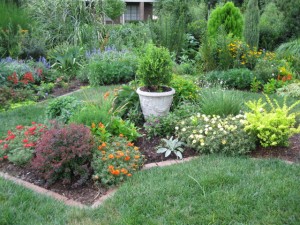
I am very fond of plants with colorful or foliage that can provide interest all growing season while the other plants come and go. I have two different barberries in the parterre near a border that goes from red to orange and then yellow.
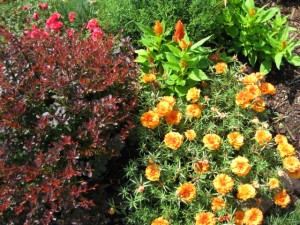
The red barberry goes well with annuals of various colors like this orange portulaca.
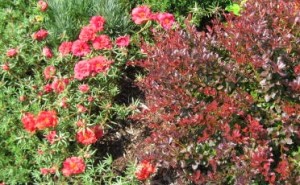
And it looks just as well as a background for red portulaca,
In part of a pastel parterre I combined pink portulaca and red leaf celosia.
img class=”aligncenter size-medium wp-image-7118″ title=”parterre pinnk” src=”https://www.karensgardentips.com/wp-content/uploads/garden/2010/07/parterre-pinnk-300×225.jpg” alt=”” width=”300″ height=”225″ />
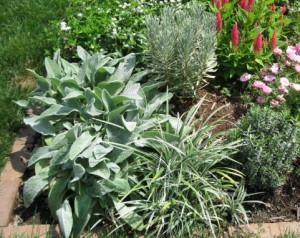
In another parterre white variegated plants euphorbia, euonymus, and lirope are companions for lamb’s ear and white gomphrena.
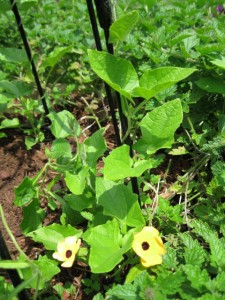
The sunflower vine in the pot in the center of the formal garden is finally taking hold and one plant has two flowers on it. I started these from seed and so they are very late but I still have hope that they will climb up the supports and cover the trellis with flowers.
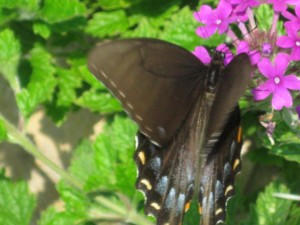
The butterflies are coming in droves. Black swallowtails have joined the yellow swallowtails that have been frequent visitors in past weeks.
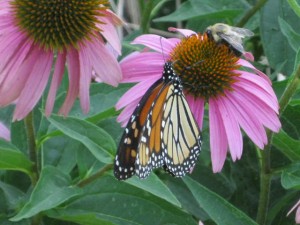
August is our usual month for seeing monarchs and the first one came this week. He seems to be unconcerned with the bee that got to the flower first.
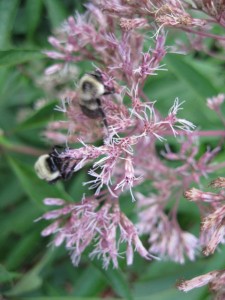
The bees seem to be more attracted to the Joe Pye weed and a constant hum emanates from the part of the garden where it grows.
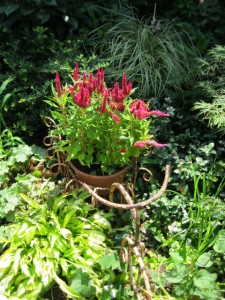
I did a little survey of volunteers this week. Some are very successful and I welcome them into my garden, like this celosia that grew in a pot last year and apparently reseeded. The plumes are not as big and showy as last year but en masse they provide a splash of color.
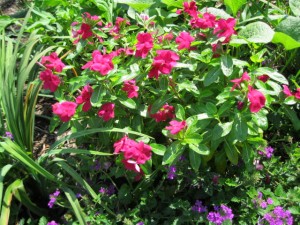
The vinca appears to have come true from seed with the same bright color and growing habits.
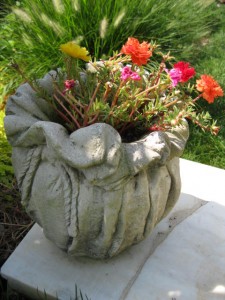
I was grateful for the portulaca that appeared in this pot. The pot has a tiny interior and so hold very little soil and moisture, making it difficult to grow most plants in it but the portulaca seems to do well.
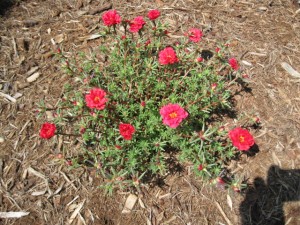
This portulaca in the dwarf conifer bed was a surprise and looks out of place so I shall probably transplant it elsewhere.
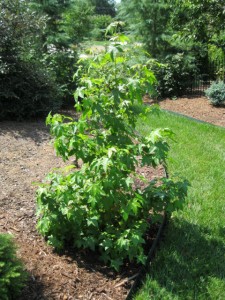
The head gardener is taking care of this sweetgum sapling so he can plant in a wet area of the garden. It probably came into our garden in the mulch.
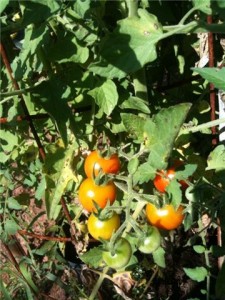
These cherry tomatoes are early and very tasty. I am always glad to see some volunteers cherry tomatoes because they usually produce tomatoes over a very long season. i never plant any and rely on volunteers.
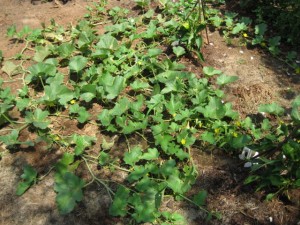
Some of my volunteers have not been so successful. This vine sprung up in an area where I grew Armenian cucumbers and cantaloupe. The vine looks like a cucumber…
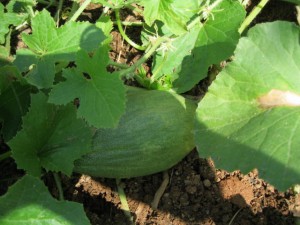
but the fruit is neither cucumber nor melon. It doesn’t look like or taste like either. I ate a large one at lunch yesterday and almost gave up because it was so hard to chew; not fibrous, just tough, like an unripe melon.
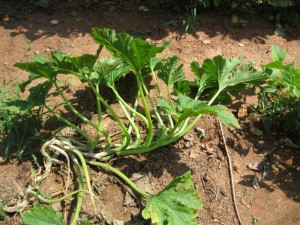
This squash is a dud too. The fruits are dreadful and don’t even look good. Some years I get tons of excellent summer squash and zucchini from volunteers but not this year.
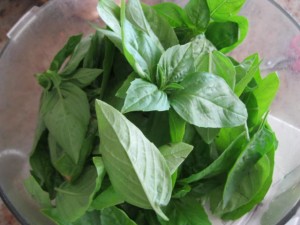
The biggest culinary success by a long shot was our basil. Using 100 leaves the head gardener made pesto.
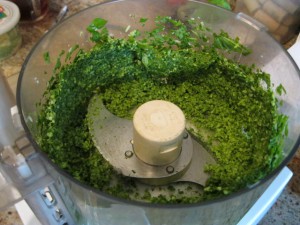
It’s hard to believe he used to use a mortar and pestle to grind up the ingredients.
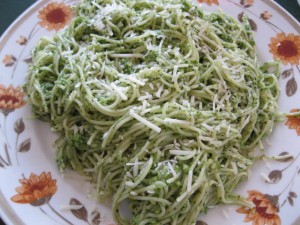
The pesto takes less time to make now than cooking the pasta.
Yum… can’t beat this for a delicious treat from the garden!
